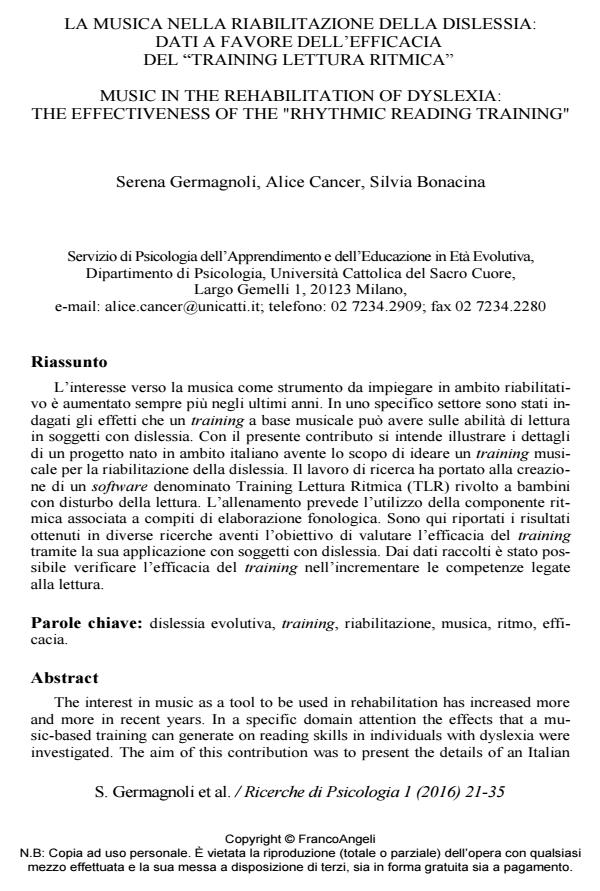La musica nella riabilitazione della dislessia: dati a favore dell’efficacia del "training lettura ritmica"
Titolo Rivista RICERCHE DI PSICOLOGIA
Autori/Curatori Serena Germagnoli, Alice Cancer, Silvia Bonacina
Anno di pubblicazione 2016 Fascicolo 2016/1
Lingua Italiano Numero pagine 15 P. 21-35 Dimensione file 100 KB
DOI 10.3280/RIP2016-001002
Il DOI è il codice a barre della proprietà intellettuale: per saperne di più
clicca qui
Qui sotto puoi vedere in anteprima la prima pagina di questo articolo.
Se questo articolo ti interessa, lo puoi acquistare (e scaricare in formato pdf) seguendo le facili indicazioni per acquistare il download credit. Acquista Download Credits per scaricare questo Articolo in formato PDF

FrancoAngeli è membro della Publishers International Linking Association, Inc (PILA)associazione indipendente e non profit per facilitare (attraverso i servizi tecnologici implementati da CrossRef.org) l’accesso degli studiosi ai contenuti digitali nelle pubblicazioni professionali e scientifiche
L’interesse verso la musica come strumento da impiegare in ambito riabilitativo è aumentato sempre più negli ultimi anni. In uno specifico settore sono stati indagati gli effetti che un training a base musicale può avere sulle abilità di lettura in soggetti con dislessia. Con il presente contributo si intende illustrare i dettagli di un progetto nato in ambito italiano avente lo scopo di ideare un training musicale per la riabilitazione della dislessia. Il lavoro di ricerca ha portato alla creazione di un software denominato Training Lettura Ritmica (TLR) rivolto a bambini con disturbo della lettura. L’allenamento prevede l’utilizzo della componente ritmica associata a compiti di elaborazione fonologica. Sono qui riportati i risultati ottenuti in diverse ricerche aventi l’obiettivo di valutare l’efficacia del training tramite la sua applicazione con soggetti con dislessia. Dai dati raccolti è stato possibile verificare l’efficacia del training nell’incrementare le competenze legate alla lettura.
Parole chiave:Dislessia evolutiva, training, riabilitazione, musica, ritmo, efficacia.
Serena Germagnoli, Alice Cancer, Silvia Bonacina, La musica nella riabilitazione della dislessia: dati a favore dell’efficacia del "training lettura ritmica" in "RICERCHE DI PSICOLOGIA " 1/2016, pp 21-35, DOI: 10.3280/RIP2016-001002